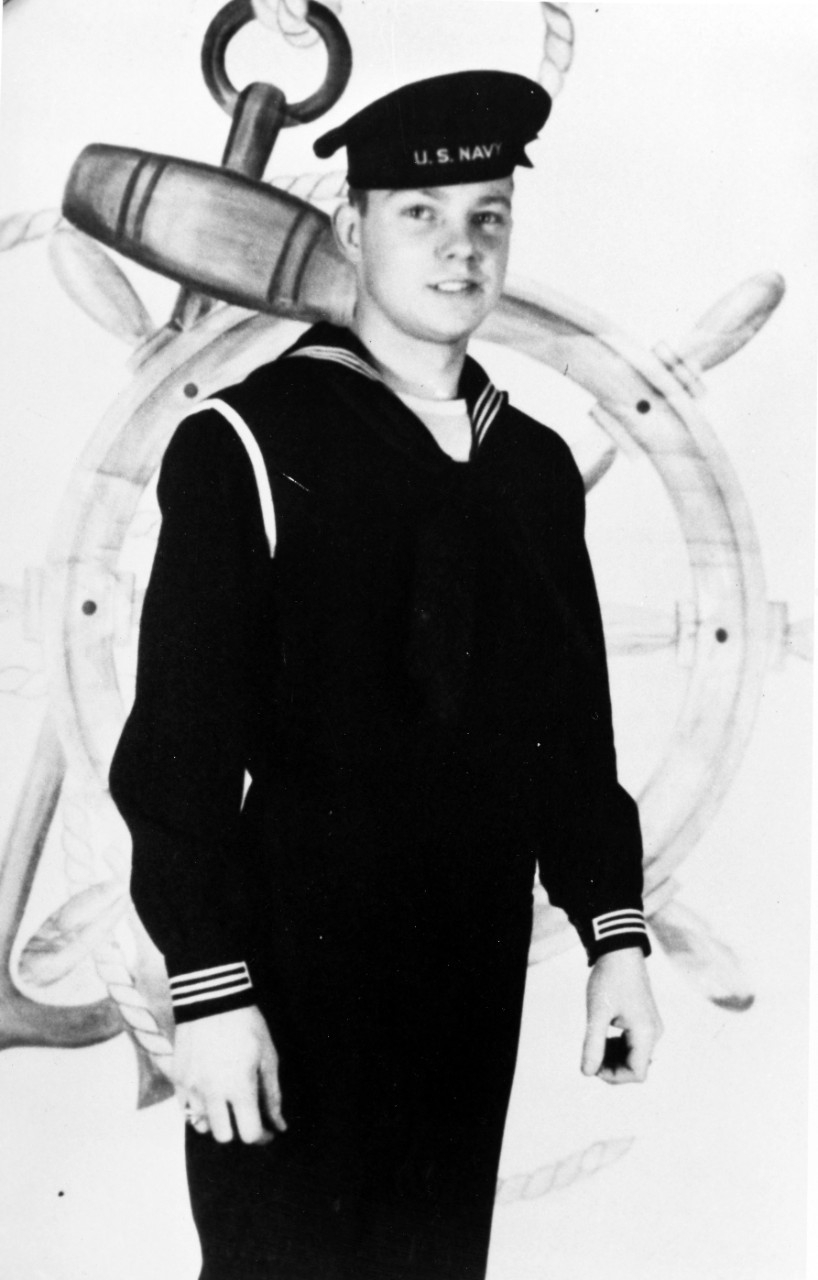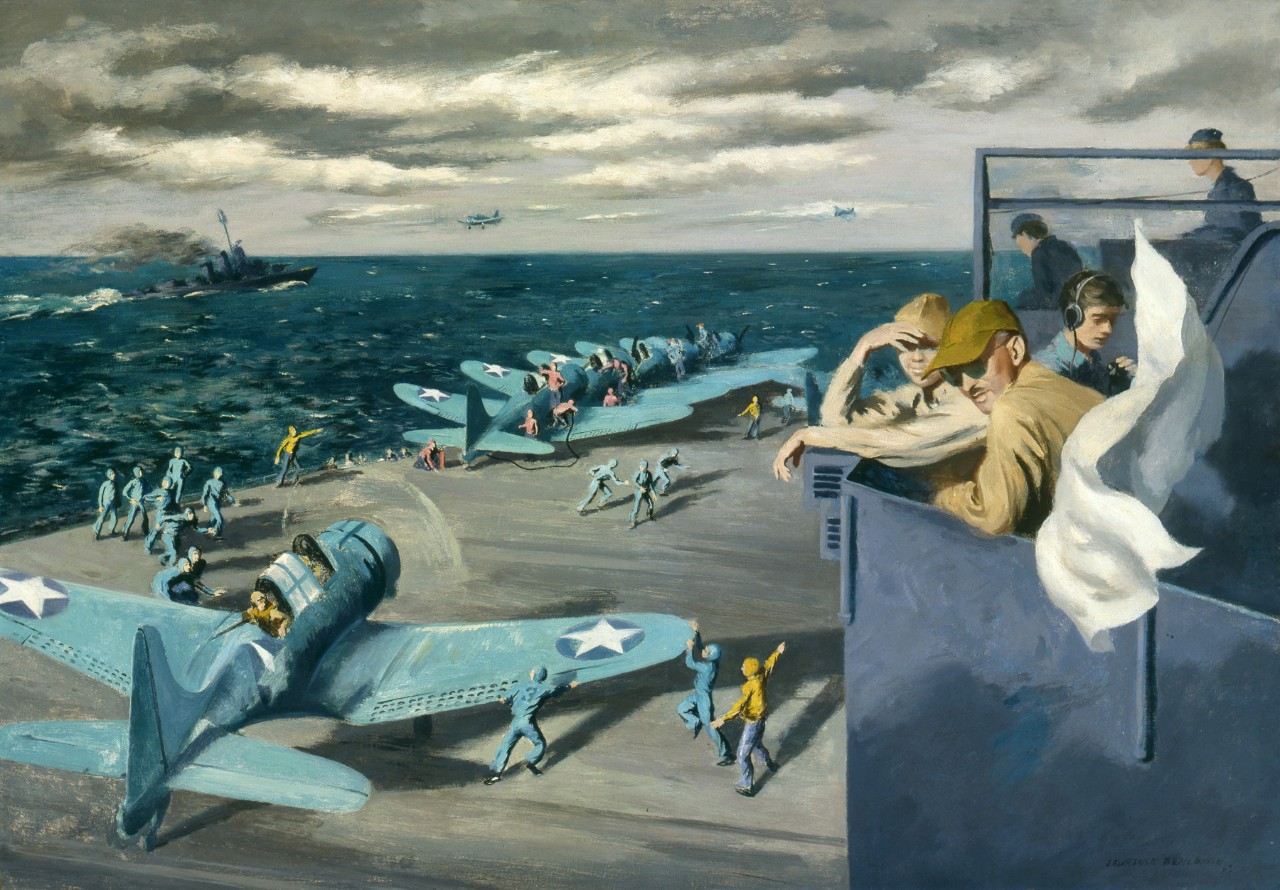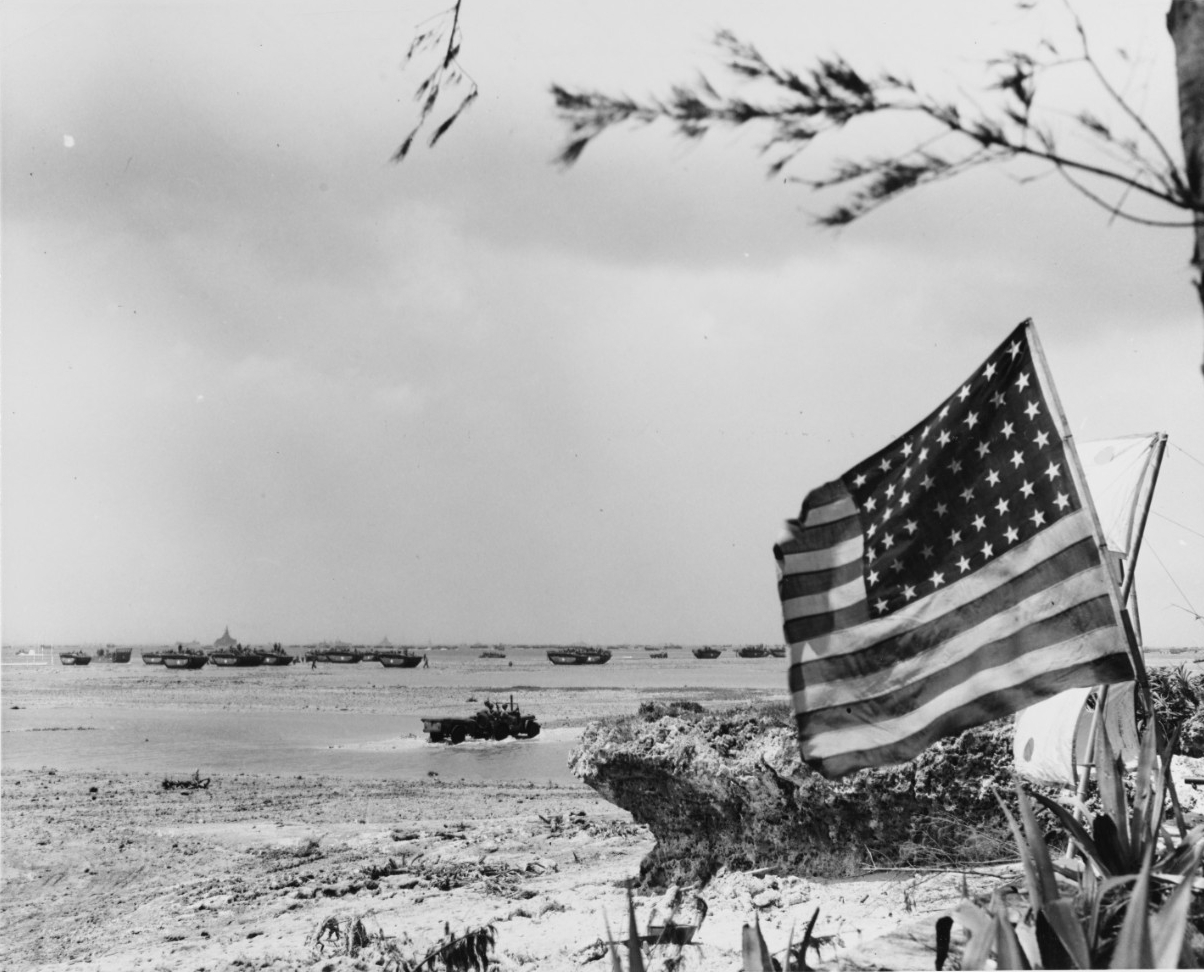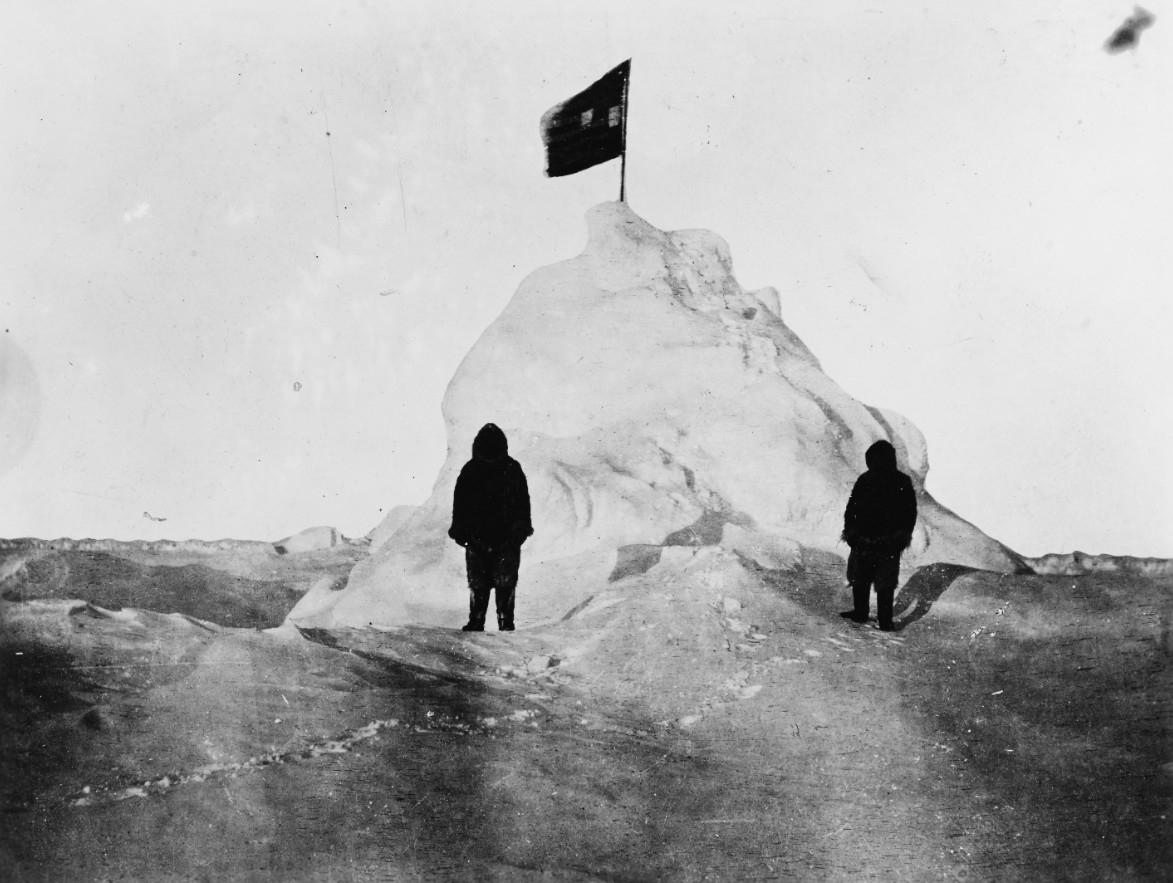Compiled by Brent Hunt, Naval History and Heritage Command’s Communication and Outreach Division
Today in Naval History
On the morning of April 5, 1951, during the Korean War, the 2nd Battalion, 7th Marines, was ordered to move forward with tanks against entrenched elements of the Chinese Communist 117th Division, 39th Corps, near Wonju. As Marines from Company D advanced up a ridge, heavy automatic weapons and small arms fire pinned down a fire team from the company’s point platoon. After seeing a fallen Marine lying seriously wounded in an exposed position, Hospital Corpsman Richard De Wert unhesitatingly rushed forward, treated the Marine’s wound, then pulled him to a protected area. Going to the aid of a second Marine and treating his wounds, the corpsman scrambled back out to the fire-swept ridge to bring back the first wounded man, suffering a leg wound while evacuating him. Seeing another wounded Marine out on the ridge, De Wert headed out a third time, but found that the man had already died. Wounded in the shoulder while checking that casualty, the gallant corpsman heard a fourth cry for help. Amidst the turmoil of the battle and still ignoring his own wounds, De Wert began to administer aid to the wounded Marine, but while doing so, was mortally wounded by a burst of enemy fire.
“For conspicuous gallantry and intrepidity at the risk of his life above and beyond the call of duty,” De Wert was awarded the Medal of Honor, posthumously. Secretary of the Navy Dan A. Kimball presented the nation’s highest honor to De Wert’s mother, Evelyn, on May 27, 1952. In honor of his bravery and sacrifice, the DeWert Naval Ambulatory Care Center in Newport, Rhode Island and USS DeWert (FFG-45) were named in his honor. Several other buildings in his Massachusetts hometown also bear his name, as does a street.
NHHC Celebrates Centennial of U.S. Navy Aircraft Carrier
Naval History and Heritage Command recently celebrated the centennial of the U.S. Navy’s use of carriers to launch and recover aircraft. The Navy’s first experimentation flying aircraft off of ships began on Nov. 14, 1910, with American civilian pilot Eugene Ely flying his Curtiss pusher airplane off a specifically built platform on the deck of cruiser Birmingham (Scout Cruiser No. 2), and then, a few months later, Ely landed on a platform built on the quarterdeck of battleship Pennsylvania (Armored Cruiser No. 4), but the Navy’s official use of the aircraft carrier began when Langley (CV-1) was commissioned in March 1922. Langley was developed from Proteus-class collier Jupiter and served as an unarmed test bed for deck and flight operations throughout the 1920s. Although the initial designs were primitive, Langley marked the birth of the most significant seaborne weapon in U.S. naval history. Langley’s successes soon sparked the production of more carriers such as Lexington (CV-2) and the first U.S. Navy ship designed and built from the keel up as an aircraft carrier, Ranger (CV-4).
During World War II, carriers were the dominant combat vessel playing leading roles in the Pacific, such as the battles of Midway, Coral Sea, and Leyte Gulf. Carriers, built during the war, continued to improve, not only in size but in lethality, as well. Catapults, flush with the deck, assisted in launching aircraft. Aircraft were fitted with retractable hooks that engaged transverse wires on the deck, braking them to a quick stop. The control centers of the carriers were situated in the superstructure (the “island”) at one side of the flight deck. Aircraft landings were guided by radio, radar, and by visual signals from the deck. “These ships are significant to U.S. naval history because of their longevity and adaptability,” said Hill Goodspeed, a historian at the National Naval Aviation Museum, in Pensacola, Florida. “In a service whose past is marked by evolving technology, it is incredible that the aircraft carrier has not only been able to endure, but remains such a viable element of the sea service. It has evolved and expanded its mission capabilities to meet new challenges and requirements.”
Carriers built after the war were even larger and came equipped with armored flight decks. The use of jet aircraft on carriers also posed significant changes, because of their greater weight, slower acceleration, higher landing speeds, and greater fuel consumption. Steam-powered catapults and angled flight decks were just some of the modifications that were installed to counter the much more powerful aircraft. In 1961, the first nuclear-powered carrier, Enterprise (CVAN-65), was commissioned. Enterprise was powered by eight nuclear reactors (two for each of its four propellers) and had a deck that was 1,101 by 252 feet (the largest at the time). Over the course of her 51-year career, Enterprise completed 25 deployments. In the wake of the 9/11 terrorist attacks, the U.S. Navy used aircraft carriers as the primary base for American air power.
“More recently, carriers have contributed immensely to the air campaigns in the Middle East,” said Dr. John D. Sherwood, a historian at NHHC. “During recent humanitarian operations such as Operation Unified Assistance—the U.S. military response to the 2004 earthquake and tsunami in Indonesia—and Operation Tomodachi—the response to the 2011 earthquake and tsunami in Japan—carriers have played an enormous role by serving as floating bases for helicopters flying in relief supplies to survivors.”
Today, the only aircraft carrier classes in service are the remaining Nimitz-class and one Gerald R. Ford-class, the planned replacement for the Nimitz carriers in the coming decades. USS Gerald R. Ford (CVN-78) is just over 1,100 feet long, has a crew of 4,500, and can carry up to 75 aircraft, to include the F35-C, the world’s first long-range stealth strike fighter. For more on the centennial of the aircraft carrier, read the NHHC press release and H-Gram 069 by NHHC Director Sam Cox. In addition, read the blogs about Essex-class aircraft carriers and women carrier aviator trailblazers at The Sextant
Battle of Okinawa: April 1, 1945
The day the Battle of Iwo Jima ended and the remote island was declared “secured,” Fifth Fleet Commander Raymond Spruance, onboard his flagship, USS Indianapolis (CA-35), steamed to the Ryukyus Islands in company with Task Force 58. In the weeks that followed, more than 1,600 ships and 350,000 personnel amassed to form one of the largest amphibious assault force of World War II. Their objective was to secure the island of Okinawa and remove the last barrier standing between the Allies and Imperial Japan. With Okinawa and Iwo Jima firmly in hand, the U.S. military could finally bring its full might upon the Japanese mainland, conducting unchecked strategic air strikes, blockading its logistics lifeline, and establishing forward bases for the planned final invasion of Japan (Operation Olympic) in the fall of 1945.
By this point, the Japanese military was greatly diminished, and naval planners expected a ferocious, fanatical resistance. In addition, Okinawa was in range of enemy land-based aircraft in Taiwan, Kyushu, and the Japanese homeland. However, instead of using the land-based aircraft for a conventional air campaign, the Japanese had other plans up their sleeves. Much like the battles at Leyte Gulf and Iwo Jima, the Japanese planned to use aircraft as human-guided missiles—kamikazes. Planners feared that as many as 3,000–4,000 aircraft could be used by the Japanese to thwart the occupation of the island. Unfortunately, their estimates would come to fruition.
Despite the threat from above, the initial stages of the Battle of Okinawa went as planned with pre-invasion bombardments from warships and tactical strikes from aircraft carriers. On April 1, 1945, Easter Sunday, Marines from the 1st and 6th Divisions, as well as Soldiers from the 96th and 7th Army Divisions, began to land on the western side of the island, and surprisingly, two airfields were taken almost immediately without contest. The ground forces then split, with Marines heading north and Soldiers to the south. By mid-April, the Marines had secured their less-defended objective, however, the Army was met with a more formidable defense. Marines would later join the Army as they slugged it out with the Japanese, suffering high casualties against the well-defended Shuri Line. The slow, methodical advance also gave Japanese kamikazes more time to attack U.S. Navy ships that were off shore supporting the assault.
The conquest of Okinawa ended on June 22, however, Americans paid a heavy price with a staggering 49,151 casualties, of which 12,520 were killed or missing. Fifth Fleet alone lost more than 4,900 personnel and 36 ships. Japanese losses were even greater with more than an estimated 110,000 killed. On an individual basis, 24 service members received the Medal of Honor for actions performed during the battle—13 went to the Marines and a Navy corpsmen, nine to Army troops, and one to a Navy officer. Winning the Battle of Okinawa put Allied forces within striking distance of Japan, but with more than 2 million Japanese troops in waiting for an eventual invasion of their country, the American public weary of the war, and the burden of American lives already lost, President Harry S. Truman approved the option to drop the atomic bomb on Hiroshima Aug. 6. A second atomic bomb dropped on Nagasaki Aug. 9 led to Japan’s surrender and the end of the war.
Naval Explorer Discovers North Pole
Commander Robert E. Peary reported reaching the North Pole April 6, 1909, dropping a note in a glass bottle into a crevice in the ice that stated: “I have this day hoisted the national ensign of the United States of America at this place, which my observations indicate to be the North Polar axis of the Earth, and have formally taken possession of the entire region, and adjacent, for and in the name of the President of the United States of America.” Peary was born May 6, 1856, son of Charles and Mary Peary. His father died when he was just three years old, and afterwards, his mother took him from Pennsylvania, where he was born, to Portland, Maine, where he spent his childhood. In 1877, he graduated from Bowdoin College in Brunswick, Maine, with a degree in civil engineering. Peary was commissioned into the U.S. Navy as a civil engineer Oct. 26, 1881, with the rank of lieutenant.
His first notable assignment was in the tropics, where he headed a party that surveyed a route for the proposed Nicaraguan Canal. After serving in the tropics, Peary’s curiosity, oddly enough, turned him to the far north. In April 1886, he was granted six months of leave to lead an expedition to Greenland, where he recorded important ethnological and meteorological observations. During the next 23 years, he led multiple expeditions to the north. His first attempt to reach the North Pole was carried out over four years (1898–1902), where he reached a point 343 miles from the pole. Four years later, he set sail northward in the steamer Roosevelt, a ship he designed specifically for arctic waters. The expedition made its way to the shores of the Polar Sea and then on to the point of 174 miles from the pole. On his third and final attempt in 1909, he finally reached the North Pole. No other human being had accomplished the feat at this point in history.
Peary’s naval career was marked by courage, integrity, and perseverance. During his second expedition to the north, he suffered an accident that resulted in a broken leg. Although the crew urged him to return to the United States for treatment, he insisted on continuing the mission. On his historic trip when he reached the North Pole, he fulfilled the parting words of President Theodore Roosevelt, “Peary, I believe in you and if it is possible for men to get there, I know you'll do it.” Perry was placed on the retired list of the Navy as a rear admiral, effective April 6, 1909, the date he discovered the North Pole. He died in Washington, DC, on Feb. 20, 1920, and is buried at Arlington National Cemetery. The ensign planted by Peary and his men at the North Pole is on display at Explorers Hall of the National Geographic Society Headquarters in Washington, DC.






